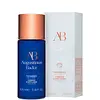What's inside
What's inside
 Key Ingredients
Key Ingredients

 Benefits
Benefits

 Concerns
Concerns

 Ingredients Side-by-side
Ingredients Side-by-side

Water
Skin ConditioningGlycerin
HumectantGluconolactone
Skin ConditioningLactobacillus/Wasabia Japonica Root Ferment Extract
AntioxidantPhytic Acid
Sodium Hydroxide
BufferingPotassium Sorbate
PreservativeXanthan Gum
EmulsifyingSodium Benzoate
MaskingSalicylic Acid
MaskingCaesalpinia Spinosa Gum
Skin ConditioningPaeonia Lactiflora Root Extract
Skin ConditioningPapain
Skin ConditioningCitric Acid
BufferingSodium Hyaluronate
HumectantHydrolyzed Rice Protein
Skin ConditioningMaltodextrin
Absorbent1,2-Hexanediol
Skin ConditioningCaprylyl Glycol
EmollientCarbomer
Emulsion StabilisingN-Hydroxysuccinimide
Skin ConditioningCamellia Sinensis Leaf Extract
AntimicrobialHydrogenated Lecithin
EmulsifyingTocopheryl Acetate
AntioxidantAlgin
MaskingAlanyl Glutamine
HumectantArginine
MaskingOligopeptide-177
Phenylalanine
MaskingSisymbrium Irio Seed Oil
MaskingSodium Chloride
MaskingWater, Glycerin, Gluconolactone, Lactobacillus/Wasabia Japonica Root Ferment Extract, Phytic Acid, Sodium Hydroxide, Potassium Sorbate, Xanthan Gum, Sodium Benzoate, Salicylic Acid, Caesalpinia Spinosa Gum, Paeonia Lactiflora Root Extract, Papain, Citric Acid, Sodium Hyaluronate, Hydrolyzed Rice Protein, Maltodextrin, 1,2-Hexanediol, Caprylyl Glycol, Carbomer, N-Hydroxysuccinimide, Camellia Sinensis Leaf Extract, Hydrogenated Lecithin, Tocopheryl Acetate, Algin, Alanyl Glutamine, Arginine, Oligopeptide-177, Phenylalanine, Sisymbrium Irio Seed Oil, Sodium Chloride
Water
Skin ConditioningGlycolic Acid
BufferingButylene Glycol
HumectantHamamelis Virginiana Water
AstringentPoloxamer 184
EmulsifyingDipropylene Glycol
HumectantPEG-40 Hydrogenated Castor Oil
EmulsifyingBenzyl Alcohol
PerfumingSodium Hydroxide
BufferingAlcohol
AntimicrobialSodium Cocoamphoacetate
CleansingDisodium Cocoamphodiacetate
CleansingUrea
BufferingSodium Chloride
MaskingParfum
MaskingDehydroacetic Acid
PreservativeDisodium EDTA
Glycerin
HumectantPanax Ginseng Root Extract
EmollientAloe Barbadensis Leaf Juice
Skin ConditioningLinalool
PerfumingLimonene
PerfumingHexyl Cinnamal
PerfumingSodium Benzoate
MaskingButylphenyl Methylpropional
PerfumingPotassium Sorbate
PreservativeCI 15985
Cosmetic ColorantWater, Glycolic Acid, Butylene Glycol, Hamamelis Virginiana Water, Poloxamer 184, Dipropylene Glycol, PEG-40 Hydrogenated Castor Oil, Benzyl Alcohol, Sodium Hydroxide, Alcohol, Sodium Cocoamphoacetate, Disodium Cocoamphodiacetate, Urea, Sodium Chloride, Parfum, Dehydroacetic Acid, Disodium EDTA, Glycerin, Panax Ginseng Root Extract, Aloe Barbadensis Leaf Juice, Linalool, Limonene, Hexyl Cinnamal, Sodium Benzoate, Butylphenyl Methylpropional, Potassium Sorbate, CI 15985
Alternatives
Ingredients Explained
These ingredients are found in both products.
Ingredients higher up in an ingredient list are typically present in a larger amount.
Glycerin is already naturally found in your skin. It helps moisturize and protect your skin.
A study from 2016 found glycerin to be more effective as a humectant than AHAs and hyaluronic acid.
As a humectant, it helps the skin stay hydrated by pulling moisture to your skin. The low molecular weight of glycerin allows it to pull moisture into the deeper layers of your skin.
Hydrated skin improves your skin barrier; Your skin barrier helps protect against irritants and bacteria.
Glycerin has also been found to have antimicrobial and antiviral properties. Due to these properties, glycerin is often used in wound and burn treatments.
In cosmetics, glycerin is usually derived from plants such as soybean or palm. However, it can also be sourced from animals, such as tallow or animal fat.
This ingredient is organic, colorless, odorless, and non-toxic.
Glycerin is the name for this ingredient in American English. British English uses Glycerol/Glycerine.
Learn more about GlycerinPotassium Sorbate is a preservative used to prevent yeast and mold in products. It is commonly found in both cosmetic and food products.
This ingredient comes from potassium salt derived from sorbic acid. Sorbic acid is a natural antibiotic and effective against fungus.
Both potassium sorbate and sorbic acid can be found in baked goods, cheeses, dried meats, dried fruit, ice cream, pickles, wine, yogurt, and more.
You'll often find this ingredient used with other preservatives.
Learn more about Potassium SorbateSodium Benzoate is a preservative. It's used in both cosmetic and food products to inhibit the growth of mold and bacteria. It is typically produced synthetically.
Both the US FDA and EU Health Committee have approved the use of sodium benzoate. In the US, levels of 0.1% (of the total product) are allowed.
Sodium benzoate works as a preservative by inhibiting the growth of bacteria inside of cells. It prevents the cell from fermenting a type of sugar using an enzyme called phosphofructokinase.
It is the salt of benzoic acid. Foods containing sodium benzoate include soda, salad dressings, condiments, fruit juices, wines, and snack foods.
Studies for using ascorbic acid and sodium benzoate in cosmetics are lacking, especially in skincare routines with multiple steps.
We always recommend speaking with a professional, such as a dermatologist, if you have any concerns.
Learn more about Sodium BenzoateChances are, you eat sodium chloride every day. Sodium Chloride is also known as table salt.
This ingredient has many purposes in skincare: thickener, emulsifier, and exfoliator.
You'll most likely find this ingredient in cleansers where it is used to create a gel-like texture. As an emulsifier, it also prevents ingredients from separating.
There is much debate on whether this ingredient is comedogenic. The short answer - comedogenic ratings don't tell the whole story. Learn more about comegodenic ratings here.
The concensus about this ingredient causing acne seems to be divided. Research is needed to understand if this ingredient does cause acne.
Scrubs may use salt as the primary exfoliating ingredient.
Learn more about Sodium ChlorideSodium Hydroxide is also known as lye or caustic soda. It is used to adjust the pH of products; many ingredients require a specific pH to be effective.
In small amounts, sodium hydroxide is considered safe to use. However, large amounts may cause chemical burns due to its high alkaline.
Your skin has a natural pH and acid mantle. This acid mantle helps prevent harmful bacteria from breaking through. The acid mantle also helps keep your skin hydrated.
"Alkaline" refers to a high pH level. A low pH level would be considered acidic.
Learn more about Sodium HydroxideWater. It's the most common cosmetic ingredient of all. You'll usually see it at the top of ingredient lists, meaning that it makes up the largest part of the product.
So why is it so popular? Water most often acts as a solvent - this means that it helps dissolve other ingredients into the formulation.
You'll also recognize water as that liquid we all need to stay alive. If you see this, drink a glass of water. Stay hydrated!
Learn more about Water